Elliott Studio Arts Model 66-001p Stereo Preamplifier
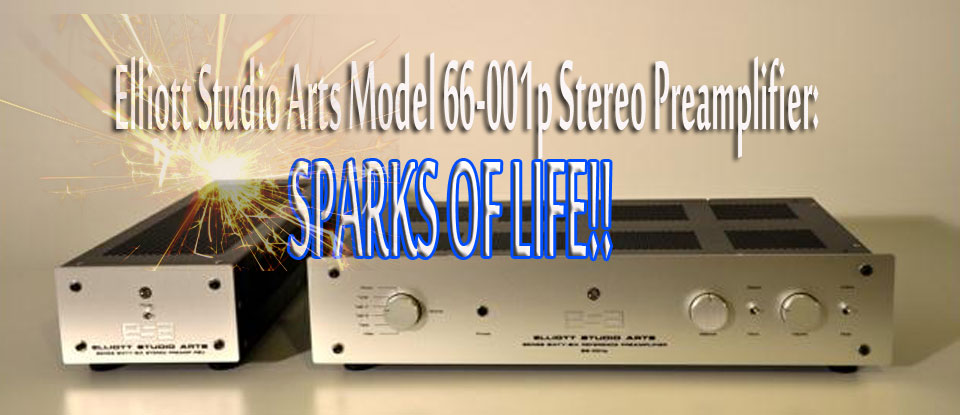
 When shopping for a new audio component, we hope to be swept away by it’s looks, operation and the veils it removes. We love it when there’s a marked improvement in sound, something tangible to help justify our effort and the purchase itself. There’s usually an obvious change in a system when speakers are upgraded and often the uninitiated will stop right there… ‘Yep, sounds different, upgraded, done.’
When shopping for a new audio component, we hope to be swept away by it’s looks, operation and the veils it removes. We love it when there’s a marked improvement in sound, something tangible to help justify our effort and the purchase itself. There’s usually an obvious change in a system when speakers are upgraded and often the uninitiated will stop right there… ‘Yep, sounds different, upgraded, done.’ Some components present a less obvious signature or improvement if you already have quality gear in your rig. You have to take the time to really listen for what isn’t there – distortion, grain – and for what is now present – better imaging, an bigger soundstage, greater dynamics both macro and micro, rhythm and pacing, all the things that make this hobby fascinating… and keep many of us upgrading.
Preamps and amplifiers can be harder to evaluate. I would say, the better they are, the more neutral they should be, imparting less of a signature on the rest of the system. Improvements in the rendering of micro dynamics, the air around instruments and the timber and texture of instruments are the hallmarks of a good component. Subtle cues in those areas make a recording far more lifelike.
As a rule, I don’t generally read any reviews or product literature past basic set up requirements to insure safe operation of the component under review. This insures a greater chance of neutrality in developing my impressions about the product. Sometime later, I’ll read product literature that informs that might alter my opinion. Such is the case with the Elliott Studio Arts Series Sixty-Six Model 66-001p Stereo Preamplifier.
The Elliott Studio Arts Series Sixty-Six 66-001p (let’s call it the ESA 66-001p) is handsomely designed and constructed with obvious care. The ESA 66-001p is custom designed and hand-built, and it shows. The build and heft of the power supply alone will convince you that this is no ordinary component. Once a component is built by Elliott Studio Arts checks out and it’s performance is stabilized, a complete battery of computer generated tests are done and documented. After the face plate is installed, the component is then inserted in Elliott’s reference system for a week of critical listening to burn in and be listened to for any anomalies prior to being packed and shipped to the customer. This assures the customer that what they get will perform at it’s best once it arrives.
Referencing Kevin Elliott’s blog, I’ll quote Mr. Elliott here: ‘The Sixty-Six Series (66-100 power amp, 66-001 preamp and derivatives) represents the premium products that we produce and will remain unchanged; full point-to-point wiring, external power supplies for the preamplifiers, engraved front panels, more robust and complex casework. I still believe that point to point is superior for tube circuits and sounds more transparent, and allows for optimum circuit component layout since it’s three-dimensional.’ Amen.
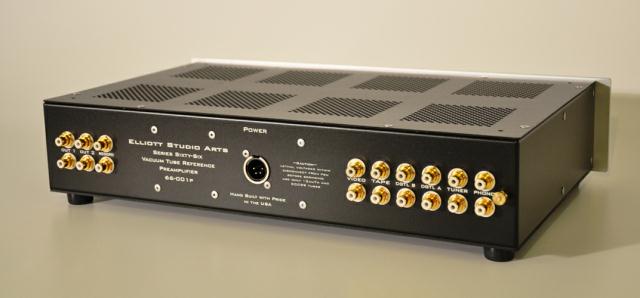

The Elliott Studio Arts 66-001p features point-to-point circuitry, hand-matched high-temperature components and wiring, and custom wound output transformers. The casework is heavy gauge steel to reduce RF and EM shielding. The manual notes that the aluminum circuit panel floats on nitrile dampeners to minimize microphonics and, quoting here: ‘The entire circuit panel provides a low-impedance ground plane for ultra low noise. The line stage runs in ‘parallel feed’ mode and utilizes local feedback to stabilize gain and lower distortion. The phono stage uses a FET / Triode cascode for high gain and low noise. Extensive capacitive bypassing at every amplification stage ensures powerful dynamic sound. The separate power supply is overbuilt utilizing computer-grade filter capacitors and a choke for an ultra-clean and ‘stiff’ reservoir. Both the high voltage for tubes and the filament supply is regulated. The AC input has RFI filtering and surge limiting.’ That’s a handful of info that provides an earful of goodness.
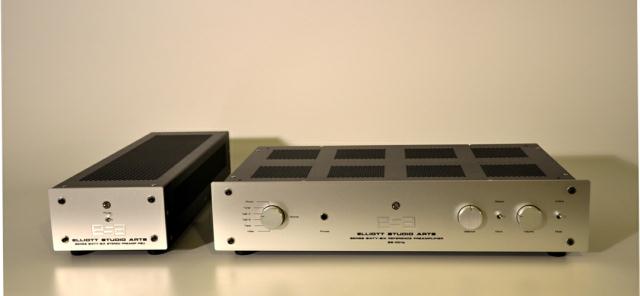
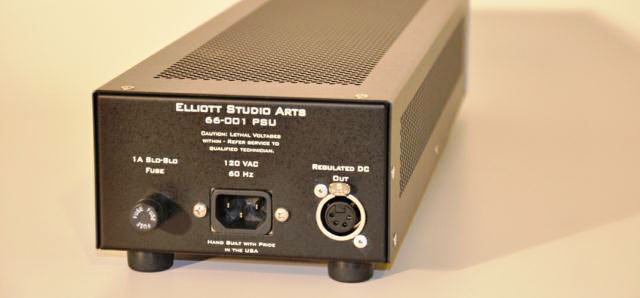
The preamp’s front panel features volume and balance controls, an active/mute switch, stereo/mono switch, source select and 1/4” stereo headphone input. The stereo headphone jack is suitable for low to medium impedance headphones, allowing a greater variety of brands to be used and, with medium impedance models, less chance of blow-out from being over-powered. The source selector includes a moving magnet phono stage, tuner, inputs for two digital sources, tape and video inputs. Elliott states ‘If your preamp is equipped with the optional HT bypass feature, any signal plugged into the ‘Video’ jacks will automatically route to the ‘output 2’ jacks when the power is off. This facilitates the use of your front channels for stereo listening through the preamp when powered up, and when powered off the preamp is bypassed so that the front channels are connected to your processor plugged into the ‘Video’ jacks.’ I can tell you first-hand that these nominal features add up to exceptional sound.
So, as usual, I carefully read the set up requirements for the Elliott and am glad I did. The manual warns you not to fire up the power supply before it’s properly connected to the preamp stage with it’s umbilical. Once properly connected, you can turn on the preamp from the switch on the power supply. It’s suggested to allow the tubes to get up to operating temperature and warm up for at least 20 minutes before any critical listening takes place. One quibble… the blue LED’s on both the preamp and power supply glow a bit too bright for my taste.
The Series Sixty-Six Model 66-001 preamp has built in RFI filtering. Elliott notes that it isn’t necessary to plug the preamp into any additional filtered power strips or conditioners, and I found this quite true. Plugged into my AudioPath PS-1 and that directly into the wall, into his preamp was exceptionally quiet at high levels, very clean and exceptionally grain free.
With the ESA Series Sixty-Six, one thing that I first noticed was the need to dial a higher volume knob position to achieve a suitable listening level. This, I thought, was a weak spot of the Elliott preamp. It even prompted me to buy a head amp for my lower output cartridges so I could lower the setting I was so often using as I generally try not to run past the noon position. Finally, upon starting the writing of the review, I could carefully read the literature that came with the preamp. To my surprise, what I initially saw as a flaw – the fact that the volume knob has to turn higher that I’m accustomed to – turned out to be a conscious design choice for better sound, and I quote from the manual: ‘The gain is also on the low side by design. You may have to turn the volume control higher than you are accustomed to. This is OK, most amplifiers will clip with as little as 1.5 volts – the 66-001p will put out a full 6 volts p – p without distortion. This gain structure was chosen to reduce noise and put the volume pot in a more linear region of its travel for average listening levels.’ What a surprise that was!
Elliott Studio Arts certainly stands behind his ESA products with a full five year limited warranty. ESA will cover under warranty any repair of our products due to defective parts or workmanship, this includes shipping damage from factory to customer. If a defect is discovered Elliott Studio Arts will, at its discretion, repair or replace the product at no charge to you provided it is returned within the warranty period. The customer must pay shipping fees to Elliott Studio Arts for warranty service. The manual clearly states what is under warranty and what is not. As a registered owner, you will be contacted if upgrades or modifications become available for your unit.
Listening
The Elliott Studio Arts 66-001p preamp was in my big rig when I reviewed the Langerton Configuration Holograf monitors, with my reference Eminent Technology LFT-8b planer magnetic hybrids used for comparison. While these two speakers couldn’t be more different in design and execution, they both share a sonic kinship that is reinforced by the Elliott’s pre’s transparency and ability to just get out of the way of the music.
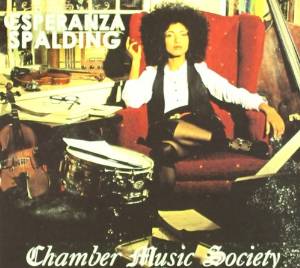 Esperanza Spalding’s ‘Chamber Music Society’ LP (2010 Heads Up), entertains us the monstrous talent of a very gifted young jazz artist. Spalding was the winner of the 2011 Grammy Award for Best New Artist, beating out Justin Bieber that year. It was inspiring to see a jazz artist honored in that way and gives this jazz lover hope for the future. This double-record set leads off with the vocal Little Fly, based on a poem by William Blake. Spalding’s’ playing,alwaysself-assured, is both punchy and forceful. Thanks to this artist being blessed with perfect pitch, the listener is rewarded with both spot on playing and accompanying vocals of surprising fluidity, both offered with such effortlessness that one forgets this artist is a very young, developing talent. Spalding’s light, airy vocals often double challenging instrumental lines throughout this album. For a person with good relative pitch, it’s a real treat for this writer to relax and appreciate such artistry… and accuracy, all accomplished without a trace of Auto-Tune.. All too often, playing and vocals not quite spot on, sound like fingernails raking across a blackboard. Not here.
Esperanza Spalding’s ‘Chamber Music Society’ LP (2010 Heads Up), entertains us the monstrous talent of a very gifted young jazz artist. Spalding was the winner of the 2011 Grammy Award for Best New Artist, beating out Justin Bieber that year. It was inspiring to see a jazz artist honored in that way and gives this jazz lover hope for the future. This double-record set leads off with the vocal Little Fly, based on a poem by William Blake. Spalding’s’ playing,alwaysself-assured, is both punchy and forceful. Thanks to this artist being blessed with perfect pitch, the listener is rewarded with both spot on playing and accompanying vocals of surprising fluidity, both offered with such effortlessness that one forgets this artist is a very young, developing talent. Spalding’s light, airy vocals often double challenging instrumental lines throughout this album. For a person with good relative pitch, it’s a real treat for this writer to relax and appreciate such artistry… and accuracy, all accomplished without a trace of Auto-Tune.. All too often, playing and vocals not quite spot on, sound like fingernails raking across a blackboard. Not here.The instrumentation and arrangements in this collection offer up a masterclass in textural content, beautifully rendered thru the ESA 66-001p preamp. Spalding, a string-player of chamber music throughout her childhood, presents us with ample rosin and bow textures within her skillfully honed string arrangements of both beauty and drive. There is intent, not mere accompaniment, in these arrangements. The Elliott preamp does a fine job imparting the textural and rhythmic content of these often challenging, propulsive tunes all displayed with great soundstage and pinpoint imaging throughout this unique and innovative recording.
There are a few noteworthy pairings on this recording. Gretchen Parlato’s breathy delivery, both alluring and fun, complements Esperanza’s soprano perfectly thru the two songs they share, especially notably on ‘Inútil Paisagem’ with it’s playful percussive vocalizing. The Elliott give each great body and presence. Esperanza’s sweet and enchanting duet with guest vocalist Milton Nascimento on ‘Apple Blossom’ is a real stand out, with it’s wonderful strings and skillfully played nylon-stringed guitar so well-recorded, complementing the playful deliveries of these two extraordinary vocalists perfectly.
 Lowell George’s solo effort ‘Thanks I’ll Eat It Here’ was played next from a self-made 24-96 rip off the original 1979 vinyl pressing. It’s a fun, bouncy album that always gets me up and my feet moving. While the spread of instruments is less intimate when compared to Spalding’s far more recent effort, the presence of George is soundly rendered and his presence felt – and missed with every play of this great album. The Elliott did an admirable job with this last 1970’s release, given the somewhat flatter sound we received in trade for multitrack recording and, no doubt, solid state mastering.
Lowell George’s solo effort ‘Thanks I’ll Eat It Here’ was played next from a self-made 24-96 rip off the original 1979 vinyl pressing. It’s a fun, bouncy album that always gets me up and my feet moving. While the spread of instruments is less intimate when compared to Spalding’s far more recent effort, the presence of George is soundly rendered and his presence felt – and missed with every play of this great album. The Elliott did an admirable job with this last 1970’s release, given the somewhat flatter sound we received in trade for multitrack recording and, no doubt, solid state mastering.Duke Ellington’s first release at the dawn of the LP era, ‘Ellington Masterpieces,’ reissued in 2014 by Acoustic Productions and Sony and pressed at QRP, is an astonishing document of Ellington’s first recorded effort to magnet tape in 1950. Thru the Elliott, it breathes as though of recent vintage, as intimate and powerful as anything I’ve heard in the past decade or two. This one recording, not the Beatles Mono box release, prompted me to get mono cartridge for my Neat idler’s rear arm. ’Masterpieces’ sounds just terrific thru the Elliott Studio Arts 66-001p preamp – truthful and realistic with dynamics and rhythmic drive that give the listener a real sense of immediacy. The textures and timbre of both the bass clarinet and sax in “Mood Indigo, the lead off track,’ are just ‘so there,’ with more than ample bass foundation, that you quickly forget this is a monophonic recording. A record not to be missed!
Summing up
There’s much to love about music played thru the Elliott Studio Arts Series Sixty-Six Model 66-001p stereo preamp. It’s quite transparent and neutral, something that can’t be said about my Conrad Johnson PV-5 preamp. While the PV-5 is clearly romantic in character and damn fun to listen to, neutral it is not.
Everything I threw at the Elliott preamp just sparkled if well recorded – and fell rather flat if not. The headphone input was a nice addition and I’m sure those given to routing audio from a video source will be a real plus. The Elliott really did get out of the way and revealed the strengths and weaknesses of the source material and shared components. In my case, things sounded great.


greg voth
Features and Specifications:
PRICE: $3990.00* (free shipping in continental US)
Line stage version: $3490.00* (free shipping in continental US)
*Non-inverting design
*Unbalanced inputs / unbalanced outputs
*Input impedance = 100K
*Fully point to point construction with high temp wiring and silver solder
*Hand-matched high quality parts used throughout
*FET / Triode cascode phono stage input topology for high gain and low noise
*MM RIAA passive equalized phono input (47K input impedance, 15pf capacitance)
*RIAA stage gain = 45dB
-S/N ratio: 76dB, reference -40dB in @ 1kHz, +5dB record out, no weighting
*Line stage gain = 14dB (can be wired for 20dB on request)
-S/N ratio: 100dB, reference 1V p-p out, no weighting
*Tube compliment: 2 ea. 12AU7A – phono stage, 2 ea. ECC99 – line stage
*High-quality Alps Blue volume pot
*Balance control out of direct signal path
*Volume and balance controls nested between amplifier stages providing constant load on phono stage and line inputs for consistent frequency response
*Mono (true summing) and Mute switches for added convenience
*5 line level inputs
*Record output jacks
*Dual main output jacks
*Optional HT bypass function
*Transformer coupled output – headphones and main outs
*8 ohm output impedance – will drive 8 ohm speaker to 1 watt!
*Fully regulated external solid state power supply for low noise
*30lb shipping weight
*5-year limited warranty on parts and labor (not tubes) –
All units are hand built personally by me, burned in and auditioned in my reference system for 1 week before shipping. All units ship with frequency response and distortion plots. Ships in sturdy carton with custom foam inserts.
Contact:
Elliott Studio Arts, LLC
Seattle, WA
Kevin Elliott, President
206-351-7248
Website: www.elliottstudioarts.com/index.html
Email: Info@elliottstudioarts.com
Stereo Times Masthead
Publisher/Founder
Clement Perry
Editor
Dave Thomas
Senior Editors
Frank Alles, Mike Girardi, Russell Lichter, Terry London, Moreno Mitchell, Paul Szabady, Bill Wells, Mike Wright, and Stephen Yan,
Current Contributors
David Abramson, Tim Barrall, Dave Allison, Ron Cook, Lewis Dardick, John Hoffman, Dan Secula, Don Shaulis, Greg Simmons, Eric Teh, Greg Voth, Richard Willie, Ed Van Winkle, Rob Dockery, Richard Doran, and Daveed Turek
Site Management Clement Perry
Ad Designer: Martin Perry





Be the first to comment on: Elliott Studio Arts Model 66-001p Stereo Preamplifier